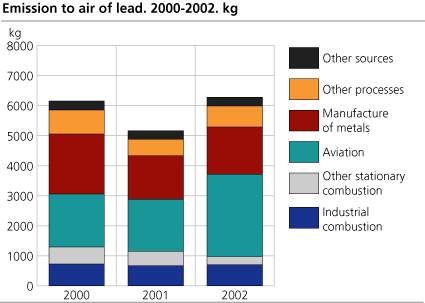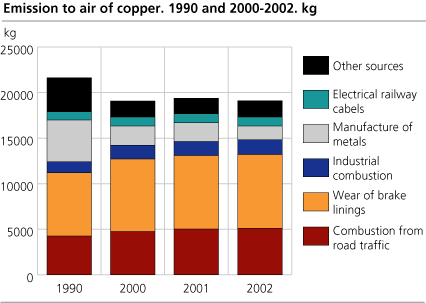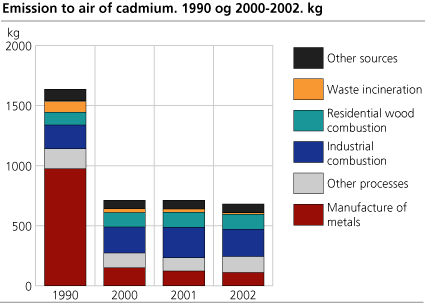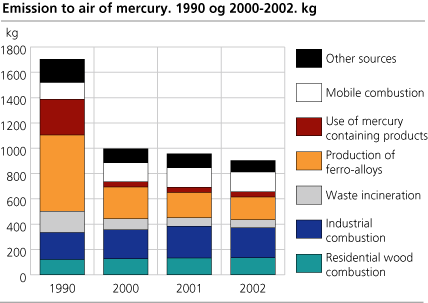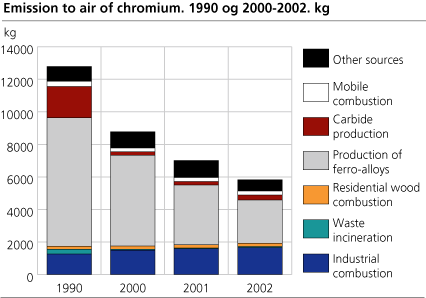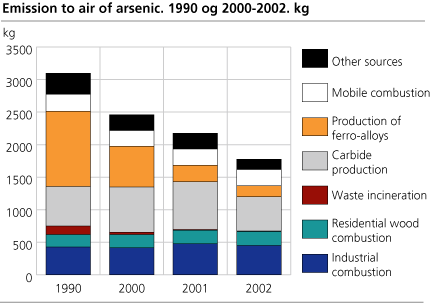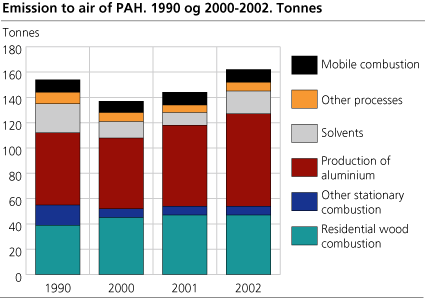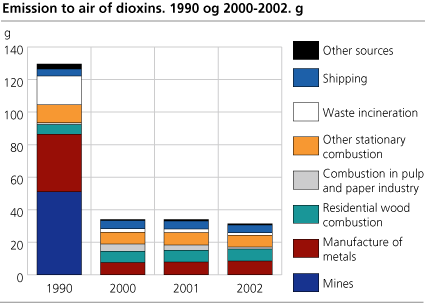Content
Published:
This is an archived release.
Emission of heavy metals down
The reduction in emissions of heavy metals to air continues. There have been decline for all heavy metals except for lead. Most of it is, however, a result of closure and reduced production in industry. Installation and better running of cleaning devices have also contributed to the reductions.
Through the Convention on Long-Range Transboundary Air Pollution, Norway is committed to reduce emissions to air of selected environmental hazardous substances from the 1990 level. The Government´s goal, set in 1997, is to reduce total emissions substantially by 2010. The decision has been made to use 1995 as the reference year for evaluations of this goal.
Closure gave less emission
Emission to air of arsenic and chromium have been reduced by 18 and 17 per cent respectively from 2001 to 2002, while mercury, cadmium and copper have been reduced from 1-6 per cent. It was mainly closure of plants, reduced production together with better running of cleaning devices which gave these reductions.
Most copper
Emission of copper to air was calculated to 19,1 ton in 2002. Road traffic is the largest source of copper emission to air. 42 per cent of the national copper emissions to air are due to wear of brake linings, whereas combustion accounts for 27 percent. Emissions from road traffic (included brake linings) have increased by 18 per cent since 1990 due to more traffic. Emission of lead to air was 6,3 ton in 2002, this is an increase since 2001 by 21 per cent. Most of the emission of lead today is due to aviation, but 80 per cent of it is emitted more than 1000 meters above the ground.
Industry important
Combustion in industry is an important source for emission to air of heavy metals. It is the most important source of air emissions for cadmium and mercury, and second largest for arsenic and chromium. Most of the emission of arsenic came from the production of carbide (30 per cent), while the production of ferroalloys is the largest source for chromium (46 per cent). Residential wood combustion is also a large source for emissions of heavy metals.
Residential wood combustion important for organic pollutants
Residential wood combustion and metallurgical industryare the most important sources for the emission of dioxins and PAH (Polycyclic Aromatic Hydrocarbons) to air in Norway today. It was emitted 31,4 gram dioxins in 2002. This is 2,6 gram less than in 2001. Most of the reduction is a result of closure of a plant, but also better cleaning devices in waste combustion contributed to the reductions. The emission of PAH has, however, increased since 2001 due to higher emissions from aluminium production.
Large reductions since 1990
Emission to air of lead has been reduced by 97 per cent since 1990 as the result of the phasing out of leaded gasoline, but there have also been large reductions in the emissions of other heavy metals since 1990. Emissions of cadmium and mercury are reduced by 58 and 47 per cent, while the emissions of arsenic, chromium and copper have been reduced by 43, 54 and 12 per cent respectively since 1990. The emission reductions are mainly due to lower emissions from metallurgical and chemical industries because of strict emission demands and closure of plants with high emissions. For mercury, emission from use of products has also been substantially reduced.
Emission to air of dioxins have been reduced by three quarters since 1990 as a result of closing down of a couple of plants with high emissions, but also less combustion of straw and combustion of waste in minor plants, in addition to phasing out of additives in petrol, contribute to reduced emissions. The emission of PAH has on the other hand shown a slight increase as a consequence of increased emission from aluminium production and residential wood combustion.
Uncertainties
The emission data are calculated by Statistics Norway in cooperation with the Norwegian Pollution Control Authority. They are based on measurements from large industrial plants and combustion plants, together with calculations based on activity data and emission factors. Large uncertainty is attached to statistics for heavy metals and persistent organic pollutants due to variations in reported emission data and because emission factors used are not necessarily ideal for conditions in Norway.
Tables in the StatBank .
Tables:
The statistics is published with Emissions to air.
Contact
-
Statistics Norway's Information Centre
E-mail: informasjon@ssb.no
tel.: (+47) 21 09 46 42

